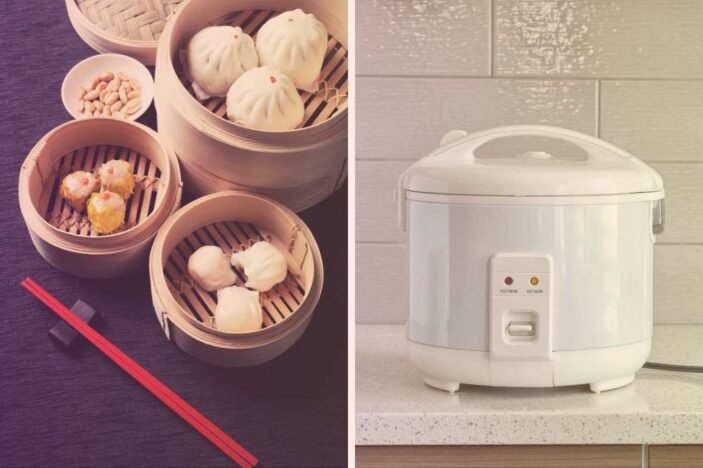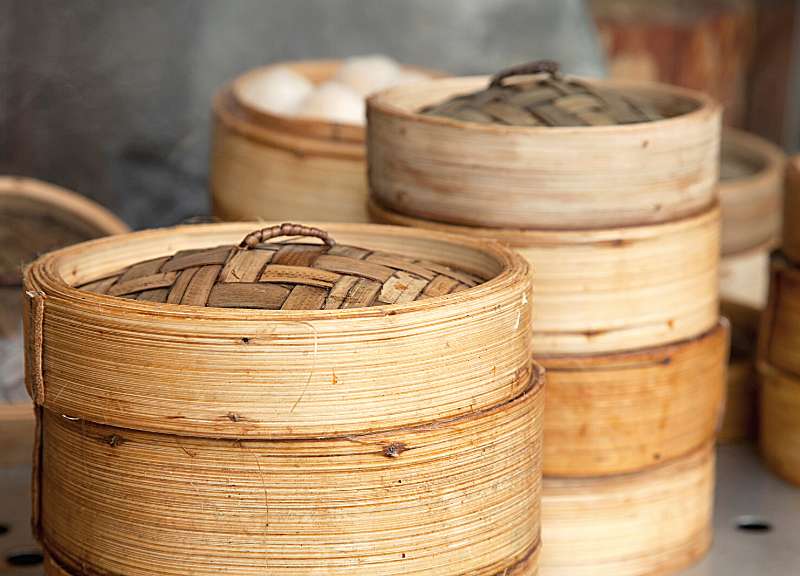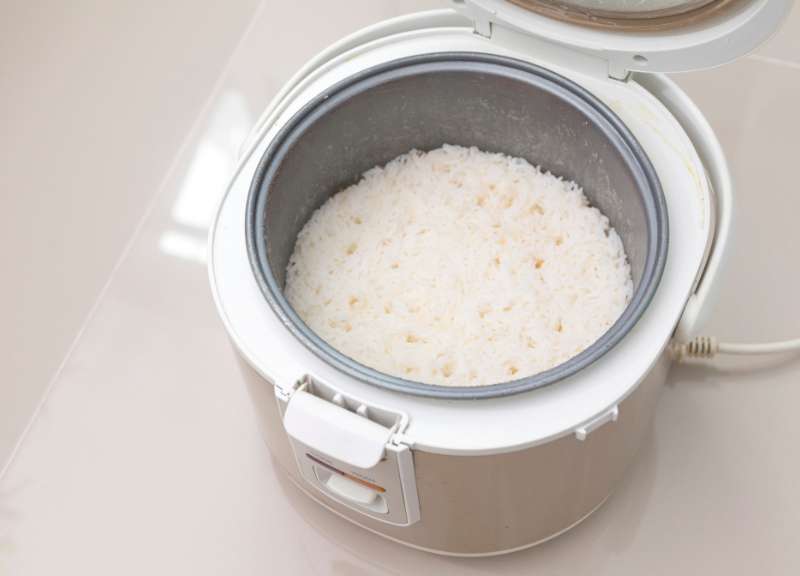Hey there! Are you a fan of rice dishes? If so, you know how important it is to get the texture and flavor of your rice just right. As someone who loves cooking and experimenting with different ingredients, I’ve tried various methods for cooking rice.
In this article, I’ll share my experience comparing two popular methods for cooking rice: the bamboo steamer and the rice cooker.
I’ll discuss each method’s benefits and drawbacks, bamboo steamer vs. rice cooker, and provide step-by-step instructions and tips to help you achieve the perfect rice.
Whether you’re a seasoned home cook or a beginner in the kitchen, I’m excited to share my insights and help you discover which method is best for cooking rice.
So, let’s dive in!
Overview Of Bamboo Steamers And Rice Cookers

If you’re new to the world of cooking, you might be wondering what bamboo steamers and rice cookers are and how they work. Well, fear not! I’m here to give you a brief overview.
Bamboo Steamers
Bamboo steamers are a traditional Asian cooking tool (especially among the Chinese community) that’s been around for centuries. They’re made from natural bamboo and come in different sizes, from small to extra-large, depending on your needs.
Bamboo steamers have several layers or baskets that stack on each other, allowing you to cook multiple dishes simultaneously.
To cook rice, you fill the bottom layer with water, which you bring to a boil to create steam. The steam then cooks the rice in the baskets above, resulting in fluffy, perfectly cooked rice.
No products found.
Related post: Bamboo Vs. Metal Steamer: Is Bamboo Or Metal Steamer Better?
Rice Cookers
On the other hand, rice cookers are a more modern kitchen appliance designed specifically for cooking rice. They come in different sizes and designs, but they all have a removable inner bowl or pot and a heating element that cooks the rice.
Some models have additional features, such as settings for different types of rice or a keep-warm function to maintain the rice’s temperature until you’re ready to serve.
Rice cookers use precise water and rice measurements and an automatic shut-off feature to ensure the rice is always perfectly cooked.
Now that you understand these two cooking tools, let’s explore their benefits and drawbacks to determine which is best for your rice-cooking needs.
No products found.
Related post: Food Steamer vs. Air Fryer: Which Is The Best?
Benefits and Drawbacks Of Using A Bamboo Steamer
Let’s delve deeper into the benefits and drawbacks of using a bamboo steamer for cooking rice.
The Benefits of Using a Bamboo Steamer:

One of the biggest advantages of using a bamboo steamer is its health benefits. Unlike boiling rice in water, steaming rice in a bamboo steamer preserves its natural flavors and nutrients.
This means the rice retains its texture, flavor, and nutritional value, making it a healthier alternative to boiled rice.
Another benefit is that it retains the natural flavor of rice. Since you’re not boiling the rice in water, it has its natural flavor and texture, making it more enjoyable to eat.
Beyond rice, a bamboo steamer can also be used for other types of cooking. I love using mine to steam vegetables, dumplings, and fish. It’s a versatile tool that can be used in various cooking styles.
Its Drawbacks
One potential drawback of using a bamboo steamer is that it can be time-consuming. Unlike a rice cooker, which can be set and left to cook, a bamboo steamer requires boiling water in a separate pot or wok before placing the steamer on top.
This extra step can take some extra time, making it less convenient if you’re in a hurry.
Another potential drawback is that it requires additional equipment. In addition to the bamboo steamer, you’ll also need a wok or pot to boil the water. This means that you’ll need to have some additional equipment on hand, which may only be feasible for some.
Lastly, bamboo steamers have a limited capacity. While you can purchase additional layers to stack on top of each other, the size of the steamer itself is still limited. This means there may be better options than cooking large amounts of rice.
Overall, the benefits of using a bamboo steamer, such as its health benefits and versatility, outweigh the drawbacks. However, it’s important to know its limitations, such as the extra time and equipment required and its limited capacity.
Benefits and Drawbacks Of Using a Rice Cooker
Now that we’ve discussed bamboo steamers, let’s move on to rice cookers. As a food lover, I can attest that rice cookers are a popular choice because of their convenience and ease of use.
Benefits of Using a Rice Cooker

One of the biggest advantages of using a rice cooker is its convenience. Press a button to add the rice and water, and the rice cooker does the rest. You don’t have to monitor it or worry about the water boiling over, which can save you time and hassle in the kitchen.
Another benefit of using a rice cooker is its versatility. Many rice cookers can cook different types of rice, such as brown rice, sushi rice, and even quinoa. Some models even have settings for steaming vegetables or cooking soups and stews.
Finally, rice cookers can keep rice warm for hours, which is perfect if you’re cooking for a large group or want to have leftovers for later.
Drawbacks of Using a Rice Cooker
One potential drawback of using a rice cooker is the cost. While budget-friendly options are available, some rice cookers can be quite expensive.
This can be a concern if you’re on a tight budget or need to cook rice more frequently to justify the cost.
Another potential drawback is that the quality of rice can vary depending on the brand and model of the rice cooker. Some models may produce softer rice, which may differ from everyone’s taste.
Overall, rice cookers are a great option for those who value convenience and ease of use in their cooking. However, there may be better choices if you’re on a tight budget or prefer a firmer texture to your rice.
Summary Table: Bamboo Steamer Vs. Rice Cooker
Here’s a summary table of the key points for each cooking method:
| Bamboo Steamer | Rice Cooker | |
|---|---|---|
| Pros | Healthier cooking option | Convenient and easy to use |
| Preserves natural flavor | Can cook a variety of rice types | |
| It can be used for other cooking | Can keep rice warm for hours | |
| Cons | Can be time-consuming | It can be expensive to purchase |
| Requires additional equipment | Quality may vary by brand/model. | |
| Limited capacity | It tends to produce softer rice. |
Cooking Rice: Bamboo Steamer vs. Rice Cooker
Now that we’ve discussed the benefits and drawbacks of bamboo steamers and rice cookers let’s move on to the practical aspect of cooking rice using these two methods.
Below, I’ll walk you through step-by-step instructions for cooking rice in a bamboo steamer and a rice cooker, as well as some tips and tricks to achieve the best results.
Cooking Rice in a Bamboo Steamer
Cooking rice in a bamboo steamer is straightforward but requires more preparation than in a rice cooker. Here are the steps to follow:
- Rinse the rice: Rinse the rice thoroughly with water until the water runs clear. This will remove excess starch and prevent the rice from becoming mushy.
- Soak the rice: Soak the rice in water for at least 30 minutes before cooking. This will help the rice cook more evenly and reduce the cooking time.
- Add water to the steamer: Add water to a pot or wok and bring it to a boil. Place the steamer on top of the pot or wok, ensuring the water level is below the steamer.
- Add rice to the steamer: Drain the soaked rice and add it to the basket. Make sure the rice is spread out evenly and not clumped together.
- Steam the rice: Cover the steamer with a lid and steam the rice for approximately 20-25 minutes. Check the rice halfway through cooking and add more water if necessary.
- Fluff the rice: Once cooked, remove the steamer from the pot or wok and let it sit for a few minutes. Use a fork to fluff the rice and serve.
Cooking Rice in a Rice Cooker
Cooking rice in a rice cooker is a simple and convenient process. Here are the steps to follow:
- Rinse the rice: Rinse the rice thoroughly with water until the water runs clear.
- Add water and rice to the rice cooker: Add the rice to the rice cooker pot and add the appropriate amount of water according to the rice cooker’s instructions.
- Cook the rice: Close the rice cooker’s lid and turn it on. The rice cooker will automatically turn off once the rice is cooked.
- Let it sit: Once the rice is cooked, sit for a few minutes before fluffing it with a fork and serving.
Comparing The Outcomes of the Two Methods
Regarding the outcome, both methods produce delicious and perfectly cooked rice. However, there are some notable differences between the two methods.
Cooking rice in a bamboo steamer produces a firmer texture and a slightly nutty flavor. The rice is also more fragrant since it’s been steamed with the natural aroma of bamboo.
On the other hand, rice cooked in a rice cooker tends to be softer and stickier, with a more uniform texture.
Related: Stovetop or Electric Pressure Cooker: Which One Should You Choose?
Tips and Tricks for Achieving the Best Results
No matter which method you choose, there are some tips and tricks you can use to achieve the best results:
- Use the right ratio of water to rice: The water needed to cook rice depends on the type of rice you’re using. Follow the instructions on the rice package or the rice cooker manual for the appropriate water ratio to rice.
- Don’t lift the lid: Avoid lifting the rice cooker’s lid or bamboo steamer while the rice is cooking. This can disrupt the cooking process and affect the texture of the rice.
- Let the rice sit: After it is cooked, sit for a few minutes before fluffing it with a fork. This allows the rice to absorb any remaining moisture, resulting in fluffier and tastier rice.
- Experiment with different types of rice: Be bold and try different types of rice with your bamboo steamer
F.A.Q.s
Can I Cook Other Types Of Food In A Rice Cooker Besides Rice?
Yes, some rice cookers come with a steam basket that allows you to cook vegetables, meat, and fish. However, a bamboo steamer may be more versatile since it can cook various foods, such as dumplings and buns.
Is A Bamboo Steamer Easy To Clean?
Yes, cleaning a bamboo steamer is relatively easy. Simply rinse it with warm water and mild soap, and use a soft brush to remove any food particles. Make sure to dry it completely before storing it to prevent mold growth.
Can I Use A Bamboo Steamer On An Induction Cooktop?
No, a bamboo steamer is not compatible with induction cooktops since it is made of wood. However, you can use it on a gas, electric, or portable gas burner.
Are Rice Cookers Safe To Use?
Yes, rice cookers are generally safe to use if you follow the manufacturer’s instructions and use them properly. Ensure to fill the rice cooker and leave it well-spaced while cooking.
Can I Cook Brown Rice In A Bamboo Steamer Or Rice Cooker?
Yes, both a bamboo steamer and a rice cooker can be used to cook brown rice. However, brown rice may take longer than white rice and require more water. Make sure to adjust the cooking time and water ratio accordingly.
Conclusion
Bamboo steamers and rice cookers have benefits and drawbacks when cooking rice. The bamboo steamer preserves rice’s natural flavor and nutritional value while being versatile, but it can be time-consuming and have a limited capacity.
The rice cooker is convenient, easy to use, and can cook different types of rice, but it may produce softer rice and be expensive to purchase.
Ultimately, choosing the two methods depends on personal preference and priorities. The bamboo steamer may be better if you prioritize health benefits and versatility.
If convenience and ease of use are more important, the rice cooker may be the way to go.
As for a final recommendation, it’s worth considering having both a bamboo steamer and rice cooker in your kitchen. This way, you can choose which method to use depending on your needs and preferences.
If you’re interested in cooking rice or want to explore other methods, plenty of resources are available online and in cookbooks. Don’t be afraid to experiment and find what works best for you and your taste buds.
Happy cooking!
Last update on 2025-12-01 / Affiliate links / Images from Amazon Product Advertising API
